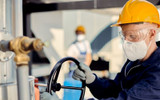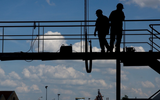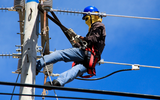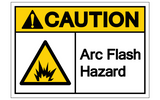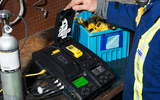Blog
How to Fit and Adjust a Fall Arrest Harness
Nothing could be more important than having the right fall protection equipment when working high up off the ground. Your employees need to know that they will be safe if a fall should occur, but a full body safety harness can easily cause problems if it’s not installed correctly. The straps and hooks will pull tight against the wearer when they are floating in the air, which can lead to circulation issues, numbness, or fainting. Your employees should also be comfortable on the job without their
…
Feb 11th 2021
What Kind of Ventilation is Needed for a Confined Space?
Confined space entry comes with plenty of risks. Basements, storage areas, attics, crawl spaces, sewers, tunnels, and other confined spaces reduce the flow of oxygen, which makes it hard to breathe. That’s why you need to install some form of ventilation to increase the airflow. But not all confined spaces are created alike. There’s a simple formula you can use to figure out exactly how much confined space ventilation is needed while occupying a space. Learn how to protect yourself and your c
…
Feb 11th 2021
How to Clean Your Gas Monitors
Thanks to the COVID-19 pandemic, workplaces are cleaning more thoroughly and frequently. If you’re in an industry that uses gas detection equipment, keeping your gas monitors clean is more important than ever to ensure you’re protected not only from atmospheric hazards, but viral hazards as well. When you clean your gas monitors, keep these procedures and precautions in mind, especially if you’re cleaning to protect against viral transmissions.
Cleaning
It’s important to properly clean
…
Jan 20th 2021
How to Select the Best Kevlar Gloves
Developed by DuPont in 1965, yarns made from Kevlar remain a very popular component in manufacturing protective safety gloves. Kevlar combines light weight with high tensile strength, along with heat and and cut resistance — qualities that make it a great material for PPE, including gloves.Buying the right pair of safety gloves for your workers doesn’t have to be overwhelming, no matter what your requirements are. When purchasing or replacing your gloves, here are six considerations you should k
…
Jan 6th 2021
How is Fall Clearance Calculated
To prevent a worker on one level from falling and striking another level or obstruction below, the fall clearance needs to be determined. This is the minimum distance needed between a worker’s feet and the lower level to keep them from hitting that lower level, and takes into account the fall protection equipment available or proposed. This calculated fall clearance can’t be equal to or greater than the physically available clearance, or else the worker will risk injury and death.VariablesMultip
…
Jan 6th 2021
How to Prevent Suspension Trauma
Suspension trauma is often overlooked in the workplace. Employers may be focused on protecting their workers from fall-related injuries but leaving them suspended in the air can also be a hazard. The human body isn’t meant to hang upright in the air for long periods of time. Learn about the best fall protection equipment and how to minimize the risk of suspension trauma with these fall protection tips.The Danger of Suspension TraumaWhen a worker falls from a ledge or elevated surface, a properly
…
Dec 18th 2020
How to Read an Arc Flash Label
An arc flash warning label is commonly used to alert workers of a potential flash fire. It comes with important safety information about the type of threat or hazard in question, so workers can either avoid this area or make sure they are wearing the proper arc flash clothing before accessing equipment or stepping inside.“Warning” or “Danger”The label will feature a “warning” or “danger” heading. “Danger” usually appears in red. It means that the nominal system voltage is over 600 or that the in
…
Dec 18th 2020
Proper FR Care: When to Repair, Replace and Wash
Fire-resistant (FR) clothing protects the worker wearing it by reacting to fire and heat differently than normal clothing does. The flame-resistant properties of FR clothing allow it to resist igniting (or extinguish quickly if it does), melting, and tearing or breaking, and they are also thermally insulated. Where possible, always look at the product manufacturer’s guidelines for maintaining your FR clothing and follow the compliance rules for your industry. Some care rules will apply to most g
…
Dec 18th 2020
How Can First Responders Protect Themselves from Carbon Monoxide Poisoning
First responders and emergency response teams should use portable carbon monoxide detectors to protect themselves and their colleagues from carbon monoxide poisoning. Without a monitor, this gas is often impossible to detect. As an odorless, tasteless, invisible gas, it is known as a “silent killer.”Carbon monoxide can easily collect in homes, businesses, vehicles, ambulances, and other confined spaces. First responders should wear this equipment when arriving on the scene, working in an unfamil
…
Dec 18th 2020
OSHA Gas Monitor Calibration Requirements: How Often Do I Need to Calibrate My Gas Detector
According to OSHA, it’s best to calibrate your multi-gas detectors and single gas monitors, before each use, but that isn’t practical for many teams. It is often better to calibrate your equipment based on the manufacturer’s guidelines, but these can be misleading as well.
Calibration will depend on the specific device in question and how often you plan on monitoring your workplace. Use this guide to keep your team safe in the field.Manual Tests
Calibrate your monitor before each use to m
…
Dec 18th 2020



